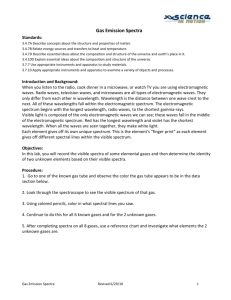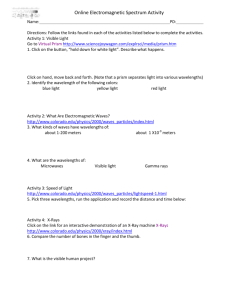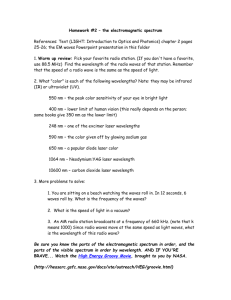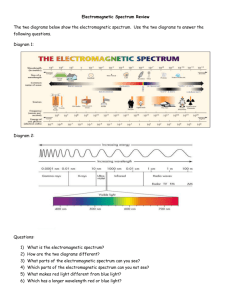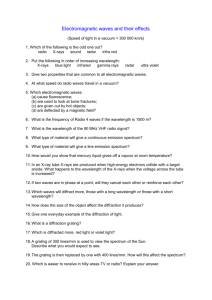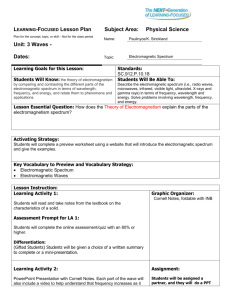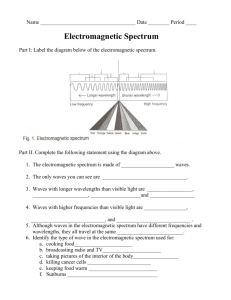Gas Emission Spectra
advertisement
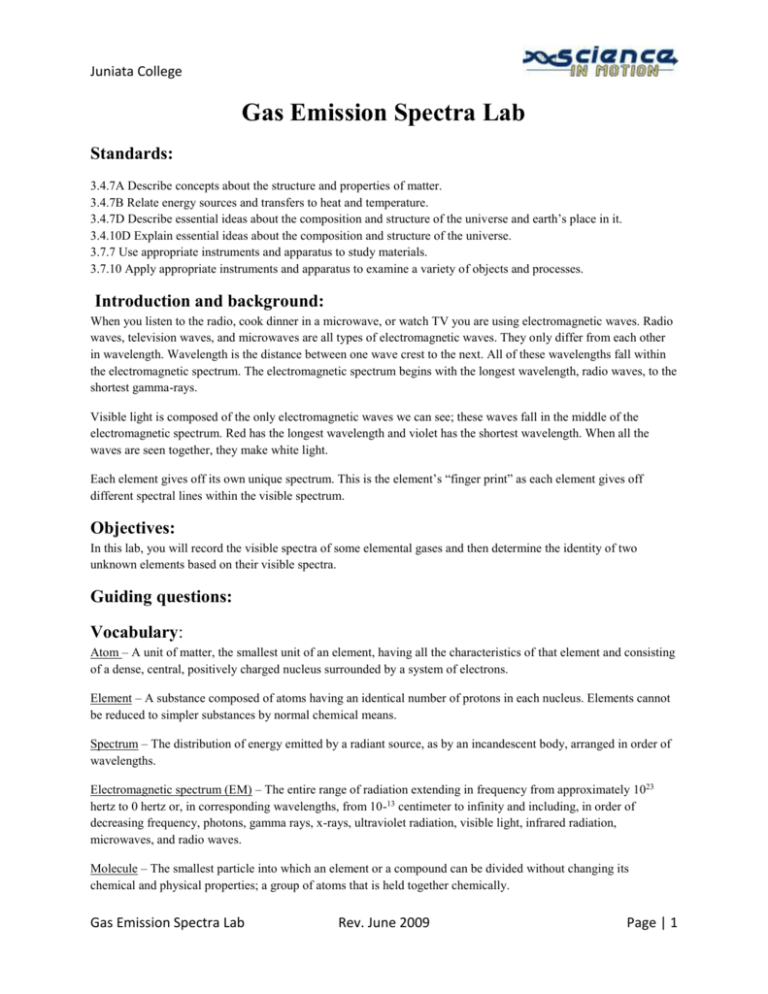
Juniata College Gas Emission Spectra Lab Standards: 3.4.7A Describe concepts about the structure and properties of matter. 3.4.7B Relate energy sources and transfers to heat and temperature. 3.4.7D Describe essential ideas about the composition and structure of the universe and earth’s place in it. 3.4.10D Explain essential ideas about the composition and structure of the universe. 3.7.7 Use appropriate instruments and apparatus to study materials. 3.7.10 Apply appropriate instruments and apparatus to examine a variety of objects and processes. Introduction and background: When you listen to the radio, cook dinner in a microwave, or watch TV you are using electromagnetic waves. Radio waves, television waves, and microwaves are all types of electromagnetic waves. They only differ from each other in wavelength. Wavelength is the distance between one wave crest to the next. All of these wavelengths fall within the electromagnetic spectrum. The electromagnetic spectrum begins with the longest wavelength, radio waves, to the shortest gamma-rays. Visible light is composed of the only electromagnetic waves we can see; these waves fall in the middle of the electromagnetic spectrum. Red has the longest wavelength and violet has the shortest wavelength. When all the waves are seen together, they make white light. Each element gives off its own unique spectrum. This is the element’s “finger print” as each element gives off different spectral lines within the visible spectrum. Objectives: In this lab, you will record the visible spectra of some elemental gases and then determine the identity of two unknown elements based on their visible spectra. Guiding questions: Vocabulary: Atom – A unit of matter, the smallest unit of an element, having all the characteristics of that element and consisting of a dense, central, positively charged nucleus surrounded by a system of electrons. Element – A substance composed of atoms having an identical number of protons in each nucleus. Elements cannot be reduced to simpler substances by normal chemical means. Spectrum – The distribution of energy emitted by a radiant source, as by an incandescent body, arranged in order of wavelengths. Electromagnetic spectrum (EM) – The entire range of radiation extending in frequency from approximately 1023 hertz to 0 hertz or, in corresponding wavelengths, from 10-13 centimeter to infinity and including, in order of decreasing frequency, photons, gamma rays, x-rays, ultraviolet radiation, visible light, infrared radiation, microwaves, and radio waves. Molecule – The smallest particle into which an element or a compound can be divided without changing its chemical and physical properties; a group of atoms that is held together chemically. Gas Emission Spectra Lab Rev. June 2009 Page | 1 Juniata College Wavelength – The distance between one peak or crest of a wave of light, sound, or other energy and the next corresponding peak or crest. Materials: Hand held diffraction gratings Gas spectrum tubes (Ne, Ar, O, Hg, He, Kr and Unknowns #1 & #2) Gas spectrum power supply Colored pencils. Spectrum reference chart. Safety: Caution students not to touch the light sources as they may be hot and the gas tubes use high voltages. Students should not insert the gas spectrum tubes in the power supply or change the gas spectrum tubes. Students should not stare directly at the light sources fro extended periods of time. Procedure: 1. Go to one of the known gas tube and observe the color the gas tube appears to be in the data section below. 2. Look through the spectroscope to see the visible spectrum of that gas. 3. Using colored pencils, color in what spectral lines you saw. 4. Continue to do this for all 6 known gases and for the 2 unknown gases. 5. After completing spectra on all 8 gases, use a reference chart and investigate what elements the 2 unknown gases are. Data table: Calculations: Questions: References: Credits: Gas Emission Spectra Lab Rev. June 2009 Page | 2


